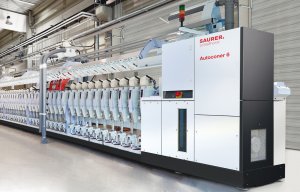
Rieter acquires Schlafhorst
The new Autoconer 6 boasts some powerful features, raising the bar for high-yield efficiency in the winding process.

25th March 2015
Innovation in Textiles
|
Übach-Palenberg
Saurer, a leading textile industry group, presents the latest Autoconer 6 automatic winding machine, equipped with improved process intelligence.
The new Autoconer 6 boasts some powerful features, such as a noticeable increase in productivity and great energy efficiency, raising the bar for high-yield efficiency in the winding process, according to the manufacturer.

Intelligently controlled self-optimisation is the major innovation topic of the sixth generation of the Autoconer winder. Automated process sequences are designed and structured to function in a self-optimising way. This is said to ensure maximum productivity, resource efficiency, quality and process reliability in winding.
The intelligent operation of the new Autoconer is said to guarantee ultimate productivity at a consistent level. The Autoconer 6 always is designed to start with optimised acceleration without slippage, reaching its maximum winding speed faster than ever before. In addition, unproductive piecing cycle times are reduced to a minimum. The anti-patterning function is optimised for productivity.
The sophisticated material flow system ensures a 100% capacity utilisation of the winding units on the automated machines even in case of material flow variations, the company reports.

The RM type has been completely redesigned. The new open design features a unique innovative bobbin change system that stores an additional bobbin in the new loading shaft and is thus ready for the change.
New efficient suction system motors, new intelligent control systems and aerodynamically improved components, such as the new suction tube, are said to reduce energy consumption and minimise yarn waste.
The new suction tube provides significantly higher resource efficiency: fast, reliable upper yarn pick-up, reduced cycle frequency and duration, automatic, self-adjusting alignment of suction tube position.

The sensor-monitored negative pressure control of the Autoconer 6 creates only as much negative pressure as needed. The suction system automatically switches back and forth between requirement-oriented, increased working pressure for a reliable yarn end pick-up and the energy saving resting vacuum. All parameters are individually adjustable.
There is no need for manual settings since the machine automatically controls everything. The intelligent system distributes the Caddies to the winding units completely autonomously, allowing the reserve bobbins to vary between 1 and 3, depending on the situation.
As before, Schlafhorst offers graduated automation solutions that are individually specified for each customer in compliance with his internal processes by choosing the matching machine type, as well as the desired bobbin and tube handling.

With its multi-tube handling and smart empty tube strategy, the X-Change package doffer features intelligent functions, unique in the market. When the doffer uses a tube format the first time, it automatically learns how to best pick up the tubes and stores the knowledge acquired in the Informator. This helps minimise set-up times and improve process reliability.
The new TensionControl and the proven Autotense FX allow the Autoconer 6 machine to offer two systems for electronic yarn tension control.
TensionControl, which is part of the basic equipment, determines the typical yarn tension progression of bobbins in the current lot on a reference winding unit and uses the measurement data to calculate a yarn tensioner curve for the lot data in the Informator. The corresponding control commands are then transmitted to all winding units.
The universal splicer module system of the Autoconer 6 is said to ensure perfectly spliced joints for every application. It takes just a few simple steps and some additional components to convert the Flexsplicer into an Elastosplicer, Thermosplicer or Injection splicer.

Business intelligence for the fibre, textiles and apparel industries: technologies, innovations, markets, investments, trade policy, sourcing, strategy...
Find out more